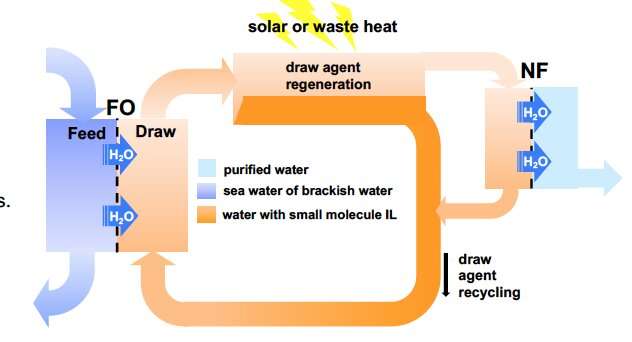Scientists cook up new recipes for taking salt out of seawater

As populations boom and chronic droughts persist, coastal cities like Carlsbad in Southern California have increasingly turned to ocean desalination to supplement a dwindling fresh water supply. Now scientists at the Department of Energy's Lawrence Berkeley National Laboratory (Berkeley Lab) investigating how to make desalination less expensive have hit on promising design rules for making so-called "thermally responsive" ionic liquids to separate water from salt.
Ionic liquids are a liquid salt that binds to water, making them useful in forward osmosis to separate contaminants from water. (See Berkeley Lab Q&A, "Moving Forward on Desalination") Even better are thermally responsive ionic liquids as they use thermal energy rather than electricity, which is required by conventional reverse osmosis (RO) desalination for the separation. The new Berkeley Lab study, published recently in the journal Nature Communications Chemistry, studied the chemical structures of several types of ionic liquid/water to determine what "recipe" would work best.
"The current state-of-the-art in RO desalination works very well, but the cost of RO desalination driven by electricity is prohibitive," said Robert Kostecki, co-corresponding author of the study. "Our study shows that the use of low-cost "free" heat—such as geothermal or solar heat or industrial waste heat generated by machines—combined with thermally responsive ionic liquids could offset a large fraction of costs that goes into current RO desalination technologies that solely rely on electricity."
Kostecki, deputy director of the Energy Storage and Distributed Resources (ESDR) Division in Berkeley Lab's Energy Technologies Area, partnered with co-corresponding author Jeff Urban, a staff scientist in Berkeley Lab's Molecular Foundry, to investigate the behavior of ionic liquids in water at the molecular level.
Using nuclear magnetic resonance spectroscopy and dynamic light scattering provided by researchers in the ESDR Division, as well as molecular dynamics simulation techniques at the Molecular Foundry, the team made an unexpected finding.

It was long thought that an effective ionic liquid separation relied on the overall ratio of organic components (parts of the ionic liquid that are neither positively or negatively charged) to its positively charged ions, explained Urban. But the Berkeley Lab team learned that the number of water molecules an ionic liquid can separate from seawater depends on the proximity of its organic components to its positively charged ions.
"This result was completely unexpected," Urban said. "With it, we now have rules of design for which atoms in ionic liquids are doing the hard work in desalination."
A decades-old membrane-based reverse osmosis technology originally developed at UCLA in the 1950s, is experiencing a resurgence—currently there are 11 desalination plants in California, and more have been proposed. Berkeley Lab scientists, through the Water-Energy Resilience Research Institute, are pursuing a range of technologies for improving the reliability of the U.S. water system, including advanced water treatments technologies such as desalination.
Because forward osmosis uses heat instead of electricity, the thermal energy can be provided by renewable sources such as geothermal and solar or industrial low-grade heat.
"Our study is an important step toward lowering the cost of desalination," added Kostecki. "It's also a great example of what's possible in the national lab system, where interdisciplinary collaborations between the basic sciences and applied sciences can lead to creative solutions to hard problems benefiting generations to come."
Also contributing to the study were researchers from UC Berkeley and Idaho National Laboratory. The Molecular Foundry is a DOE Office of Science User Facility that specializes in nanoscale science. This work was supported by the U.S. Department of Energy's Office of Energy Efficiency and Renewable Energy.
More information: Hyungmook Kang et al, Molecular insight into the lower critical solution temperature transition of aqueous alkyl phosphonium benzene sulfonates, Nature Communications Chemistry (2019). DOI: 10.1038/s42004-019-0151-2
Provided by Lawrence Berkeley National Laboratory



















